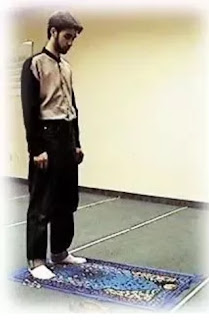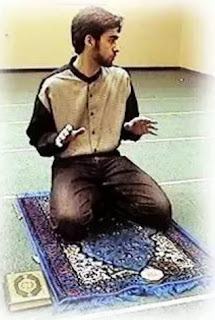In The Name of Allah, The Most Beneficent, The Most Merciful
It is impossible to explain how to pray in short article like this and it is a big responsibility to teach people something this important. However, the greater responsibility is to introduce the basic and leave the research for the reader. Before praying you have to make a wodho, be sure you are pure and clean, and your dress is appropriate(research more about this part). Ladies should wear a clothe where only their face, hands (to the wrist, not arms) and their feet (to their ankle) is shown, and male are required to cover their body appropriately as well.
Neiat and Ghera'at
Neiat or intention is the most important part of the prayer. By this you say that why you are standing for prayer, which prayer, how many rakats. You can say it loud or in your mind.
For example: I will pray the salat al-Fajr, two ra'akat, gurbatan ela-laah, (to get closer to Allah).
It doesn't matter what language you say it, as long as you have the intention. This is the way you should stand and put your hands during this stage:
(fig 1)

Then you do your Takbiratul-Ehram (saying Allah Akbar)and drop your hands, from ears to your laps. Now you entered prayer officially and from this point till salam you can't talk, eat, or move out of prayer's form. Start your prayer by reading Al-Hamd and the sura (fig 2). You have to say everything in Arabic and learning it is very easy just need practice, you can ask some of the Muslims or people who know Arabic to read the right pronunciation for you. In this part you would read two chapters, Reading the chapter al-Hamd is necessary but choosing the sura is up to you, people read the chapter of Ekhlas mostly. The way to stand and read is in the figure 2.
(fig 2)

Rakat
Rakat consist of Gera'at (reading of the al-hamd and sura, or Tasbeehat al-Arba'a), one Ruku'e, and two Sajda.
Ruku'e
After you read the Al-hamd and sura you bend by placing your hands on your knees and looking between your legs, this is called Ruku'e. And you say a Thekr (praise to Allah). To make it easy on the beginners you would say Subhan-Allah 3 times or you can refer to the people who pray for their thekr. Fig 3 explains how you have to do this part.
(fig 3)

Qunut
Qunut is the part you raise your hand and ask Allah for what you need you can say it in any language or just say a short grace in Arabic. Qunut is performed after the Al-hamd and Sura recitation of the second rakat and it is not required (wajeb) but is Mustahab (recommended). The way to do this part is explained in figure 4.

Sajda
After Ruku'e you stand straight like you started and then go to Sajda. In this part you prostrate to Allah. That means you place seven part of your body touching the ground and say a thekr similar to the one in Ruku'e, your forehead, palms, knees, and your toes. Your forhead should be on a wooden or stone made object (see more details on this part). You did one Sajda, like in fig 5, you sit like your in Tashahood, and do another one after that.
(fig 5)

Tashahud
After performing your second sajda on the second rakat of every prayer and the last rakat of the particular prayer your performing, you perform Tashahud. In this part you would sit in a way that your left foot is on your right [it is more mustahab to place the upper part of the right foot on the sole of the left foot] and your palms are on your thighs. And you read Tashahud in Arabic (see fig 6). This part is to be performed on every two Rakats and before you finish salat. Example if you are doing the Dohr, Asr, and Esha prayers which are four Rakats you do Tashahood in the end of second Rakat and at the end of fourth Rakat before saying the Salam. And if you praying the Maghreb prayer which is three Rakat's you do Tashahood at the end of second Rakat and the third Rakat before finishing the prayer. The meaning of it is:
I bear witness that there is no god but Allah, He is one and no one is like him, And I bear witness that Mohammad is his conformer (Ab'd) and his messenger, O'Allah send greetings to Mohammad and the Family of Mohammad.
(fig 6)

Salam
This is the end part of salat and by reciting this part you officially end your prayer. You would read it at the end of the last Rakat (after the second sajda) and you finish your prayer. After reading it you would raise your palms from your thigh and say Allah'u Akbar and put your hands back on the thighs for three times (see fig 7). You read it in Arabic and pronunciation is Here. The meaning of the reading it is
Greetings to us and to the faithful (Saleheen) conformers' of Allah, Greetings and Mercy of Allah be onto you.
(fig 7)

Tasbeehat' al-Arba'a
This part is for prayers other than Fajr prayer which have more than 2 Rakats and it replaces the reading of Al-hamd and the Sura. You can say this thekr (prefered) or you can simply read the Al-hamd chapter only with low voice. This is the pronunciation of the thekr:
Subhanal'lah, Wal-hamdule'lah,
Wala Elaha Elallah'u, Wa'llah'u Akbar.
Which means clean and pure is Allah, and thanks to Allah, and no god but Allah, and Allah is great. There is four parts to it and that is why it is called Tasbeehat al-Arba'a. You can say this thekr only once or three times.
[Mod Note: To add clarification that in Tashahud it is more mustahab to place the upper part of the right foot on the sole of the left foot.]

